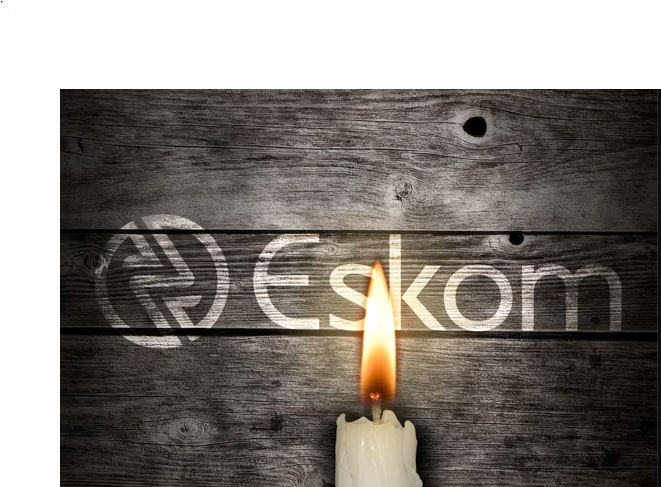They were the first nationwide power cuts in around six months in South Africa which has become used to blackouts due to technical and financial problems at Eskom.
Eskom said in a statement that it would cut around 2,000 megawatts (MW) of power from 9 a.m. local time (0700 GMT) until 11 p.m. (2100 GMT) on a rotational basis across the country.
The rand ZAR=D3 fell by around 1% against the dollar on the news as frequent power cuts have put pressure on South Africa’s economy.
Eskom said more than 10,500 MW of its roughly 45,000 MW capacity was offline because of unplanned breakdowns. Five generating units were unavailable because of boiler tube leaks, and a conveyer belt supplying coal to the mammoth Medupi power station had failed.
Due to a shortage of coal generation, Eskom’s supplies of water for its pumped storage and diesel for its open-cycle gas turbines had run low.
Eskom produces more than 90% of South Africa’s electricity, but has been hobbled by technical faults at its fleet of coal-fired power stations as well as a financial crisis that resulted in a loss of more than 20 billion rand ($1.3 billion) last year.
A debilitating round of power cuts in February and March contributed to a steep economic contraction in the first quarter and reminded investors of the uphill struggle President Cyril Ramaphosa faces to revive Africa’s most industrialized economy.
The government plans to split Eskom into three units for generation, transmission and distribution to make it more efficient and has also proposed more than 100 billion rand of bailouts over the next two years. But some analysts say that isn’t enough.
The power cuts highlight the challenge the government faces to turn the utility around.
They come at a critical time for energy policy, as cabinet ministers prepare to debate the country’s long-term electricity generation plan this week.
The government is also expected to announce a new chief executive for Eskom this month and publish a paper laying out its plans to reform the struggling utility.
On Wednesday a prominent business lobby group called for decisive action on Eskom to support economic growth.
They were the first nationwide power cuts in around six months in South Africa which has become used to blackouts due to technical and financial problems at Eskom.
Eskom said in a statement that it would cut around 2,000 megawatts (MW) of power from 9 a.m. local time (0700 GMT) until 11 p.m. (2100 GMT) on a rotational basis across the country.
The rand ZAR=D3 fell by around 1% against the dollar on the news as frequent power cuts have put pressure on South Africa’s economy.
Eskom said more than 10,500 MW of its roughly 45,000 MW capacity was offline because of unplanned breakdowns. Five generating units were unavailable because of boiler tube leaks, and a conveyer belt supplying coal to the mammoth Medupi power station had failed.
Due to a shortage of coal generation, Eskom’s supplies of water for its pumped storage and diesel for its open-cycle gas turbines had run low.
Eskom produces more than 90% of South Africa’s electricity, but has been hobbled by technical faults at its fleet of coal-fired power stations as well as a financial crisis that resulted in a loss of more than 20 billion rand ($1.3 billion) last year.
A debilitating round of power cuts in February and March contributed to a steep economic contraction in the first quarter and reminded investors of the uphill struggle President Cyril Ramaphosa faces to revive Africa’s most industrialized economy.
The government plans to split Eskom into three units for generation, transmission and distribution to make it more efficient and has also proposed more than 100 billion rand of bailouts over the next two years. But some analysts say that isn’t enough.
The power cuts highlight the challenge the government faces to turn the utility around.
They come at a critical time for energy policy, as cabinet ministers prepare to debate the country’s long-term electricity generation plan this week.
The government is also expected to announce a new chief executive for Eskom this month and publish a paper laying out its plans to reform the struggling utility.
On Wednesday a prominent business lobby group called for decisive action on Eskom to support economic growth.
They were the first nationwide power cuts in around six months in South Africa which has become used to blackouts due to technical and financial problems at Eskom.
Eskom said in a statement that it would cut around 2,000 megawatts (MW) of power from 9 a.m. local time (0700 GMT) until 11 p.m. (2100 GMT) on a rotational basis across the country.
The rand ZAR=D3 fell by around 1% against the dollar on the news as frequent power cuts have put pressure on South Africa’s economy.
Eskom said more than 10,500 MW of its roughly 45,000 MW capacity was offline because of unplanned breakdowns. Five generating units were unavailable because of boiler tube leaks, and a conveyer belt supplying coal to the mammoth Medupi power station had failed.
Due to a shortage of coal generation, Eskom’s supplies of water for its pumped storage and diesel for its open-cycle gas turbines had run low.
Eskom produces more than 90% of South Africa’s electricity, but has been hobbled by technical faults at its fleet of coal-fired power stations as well as a financial crisis that resulted in a loss of more than 20 billion rand ($1.3 billion) last year.
A debilitating round of power cuts in February and March contributed to a steep economic contraction in the first quarter and reminded investors of the uphill struggle President Cyril Ramaphosa faces to revive Africa’s most industrialized economy.
The government plans to split Eskom into three units for generation, transmission and distribution to make it more efficient and has also proposed more than 100 billion rand of bailouts over the next two years. But some analysts say that isn’t enough.
The power cuts highlight the challenge the government faces to turn the utility around.
They come at a critical time for energy policy, as cabinet ministers prepare to debate the country’s long-term electricity generation plan this week.
The government is also expected to announce a new chief executive for Eskom this month and publish a paper laying out its plans to reform the struggling utility.
On Wednesday a prominent business lobby group called for decisive action on Eskom to support economic growth.
They were the first nationwide power cuts in around six months in South Africa which has become used to blackouts due to technical and financial problems at Eskom.
Eskom said in a statement that it would cut around 2,000 megawatts (MW) of power from 9 a.m. local time (0700 GMT) until 11 p.m. (2100 GMT) on a rotational basis across the country.
The rand ZAR=D3 fell by around 1% against the dollar on the news as frequent power cuts have put pressure on South Africa’s economy.
Eskom said more than 10,500 MW of its roughly 45,000 MW capacity was offline because of unplanned breakdowns. Five generating units were unavailable because of boiler tube leaks, and a conveyer belt supplying coal to the mammoth Medupi power station had failed.
Due to a shortage of coal generation, Eskom’s supplies of water for its pumped storage and diesel for its open-cycle gas turbines had run low.
Eskom produces more than 90% of South Africa’s electricity, but has been hobbled by technical faults at its fleet of coal-fired power stations as well as a financial crisis that resulted in a loss of more than 20 billion rand ($1.3 billion) last year.
A debilitating round of power cuts in February and March contributed to a steep economic contraction in the first quarter and reminded investors of the uphill struggle President Cyril Ramaphosa faces to revive Africa’s most industrialized economy.
The government plans to split Eskom into three units for generation, transmission and distribution to make it more efficient and has also proposed more than 100 billion rand of bailouts over the next two years. But some analysts say that isn’t enough.
The power cuts highlight the challenge the government faces to turn the utility around.
They come at a critical time for energy policy, as cabinet ministers prepare to debate the country’s long-term electricity generation plan this week.
The government is also expected to announce a new chief executive for Eskom this month and publish a paper laying out its plans to reform the struggling utility.
On Wednesday a prominent business lobby group called for decisive action on Eskom to support economic growth.
They were the first nationwide power cuts in around six months in South Africa which has become used to blackouts due to technical and financial problems at Eskom.
Eskom said in a statement that it would cut around 2,000 megawatts (MW) of power from 9 a.m. local time (0700 GMT) until 11 p.m. (2100 GMT) on a rotational basis across the country.
The rand ZAR=D3 fell by around 1% against the dollar on the news as frequent power cuts have put pressure on South Africa’s economy.
Eskom said more than 10,500 MW of its roughly 45,000 MW capacity was offline because of unplanned breakdowns. Five generating units were unavailable because of boiler tube leaks, and a conveyer belt supplying coal to the mammoth Medupi power station had failed.
Due to a shortage of coal generation, Eskom’s supplies of water for its pumped storage and diesel for its open-cycle gas turbines had run low.
Eskom produces more than 90% of South Africa’s electricity, but has been hobbled by technical faults at its fleet of coal-fired power stations as well as a financial crisis that resulted in a loss of more than 20 billion rand ($1.3 billion) last year.
A debilitating round of power cuts in February and March contributed to a steep economic contraction in the first quarter and reminded investors of the uphill struggle President Cyril Ramaphosa faces to revive Africa’s most industrialized economy.
The government plans to split Eskom into three units for generation, transmission and distribution to make it more efficient and has also proposed more than 100 billion rand of bailouts over the next two years. But some analysts say that isn’t enough.
The power cuts highlight the challenge the government faces to turn the utility around.
They come at a critical time for energy policy, as cabinet ministers prepare to debate the country’s long-term electricity generation plan this week.
The government is also expected to announce a new chief executive for Eskom this month and publish a paper laying out its plans to reform the struggling utility.
On Wednesday a prominent business lobby group called for decisive action on Eskom to support economic growth.
They were the first nationwide power cuts in around six months in South Africa which has become used to blackouts due to technical and financial problems at Eskom.
Eskom said in a statement that it would cut around 2,000 megawatts (MW) of power from 9 a.m. local time (0700 GMT) until 11 p.m. (2100 GMT) on a rotational basis across the country.
The rand ZAR=D3 fell by around 1% against the dollar on the news as frequent power cuts have put pressure on South Africa’s economy.
Eskom said more than 10,500 MW of its roughly 45,000 MW capacity was offline because of unplanned breakdowns. Five generating units were unavailable because of boiler tube leaks, and a conveyer belt supplying coal to the mammoth Medupi power station had failed.
Due to a shortage of coal generation, Eskom’s supplies of water for its pumped storage and diesel for its open-cycle gas turbines had run low.
Eskom produces more than 90% of South Africa’s electricity, but has been hobbled by technical faults at its fleet of coal-fired power stations as well as a financial crisis that resulted in a loss of more than 20 billion rand ($1.3 billion) last year.
A debilitating round of power cuts in February and March contributed to a steep economic contraction in the first quarter and reminded investors of the uphill struggle President Cyril Ramaphosa faces to revive Africa’s most industrialized economy.
The government plans to split Eskom into three units for generation, transmission and distribution to make it more efficient and has also proposed more than 100 billion rand of bailouts over the next two years. But some analysts say that isn’t enough.
The power cuts highlight the challenge the government faces to turn the utility around.
They come at a critical time for energy policy, as cabinet ministers prepare to debate the country’s long-term electricity generation plan this week.
The government is also expected to announce a new chief executive for Eskom this month and publish a paper laying out its plans to reform the struggling utility.
On Wednesday a prominent business lobby group called for decisive action on Eskom to support economic growth.
They were the first nationwide power cuts in around six months in South Africa which has become used to blackouts due to technical and financial problems at Eskom.
Eskom said in a statement that it would cut around 2,000 megawatts (MW) of power from 9 a.m. local time (0700 GMT) until 11 p.m. (2100 GMT) on a rotational basis across the country.
The rand ZAR=D3 fell by around 1% against the dollar on the news as frequent power cuts have put pressure on South Africa’s economy.
Eskom said more than 10,500 MW of its roughly 45,000 MW capacity was offline because of unplanned breakdowns. Five generating units were unavailable because of boiler tube leaks, and a conveyer belt supplying coal to the mammoth Medupi power station had failed.
Due to a shortage of coal generation, Eskom’s supplies of water for its pumped storage and diesel for its open-cycle gas turbines had run low.
Eskom produces more than 90% of South Africa’s electricity, but has been hobbled by technical faults at its fleet of coal-fired power stations as well as a financial crisis that resulted in a loss of more than 20 billion rand ($1.3 billion) last year.
A debilitating round of power cuts in February and March contributed to a steep economic contraction in the first quarter and reminded investors of the uphill struggle President Cyril Ramaphosa faces to revive Africa’s most industrialized economy.
The government plans to split Eskom into three units for generation, transmission and distribution to make it more efficient and has also proposed more than 100 billion rand of bailouts over the next two years. But some analysts say that isn’t enough.
The power cuts highlight the challenge the government faces to turn the utility around.
They come at a critical time for energy policy, as cabinet ministers prepare to debate the country’s long-term electricity generation plan this week.
The government is also expected to announce a new chief executive for Eskom this month and publish a paper laying out its plans to reform the struggling utility.
On Wednesday a prominent business lobby group called for decisive action on Eskom to support economic growth.
They were the first nationwide power cuts in around six months in South Africa which has become used to blackouts due to technical and financial problems at Eskom.
Eskom said in a statement that it would cut around 2,000 megawatts (MW) of power from 9 a.m. local time (0700 GMT) until 11 p.m. (2100 GMT) on a rotational basis across the country.
The rand ZAR=D3 fell by around 1% against the dollar on the news as frequent power cuts have put pressure on South Africa’s economy.
Eskom said more than 10,500 MW of its roughly 45,000 MW capacity was offline because of unplanned breakdowns. Five generating units were unavailable because of boiler tube leaks, and a conveyer belt supplying coal to the mammoth Medupi power station had failed.
Due to a shortage of coal generation, Eskom’s supplies of water for its pumped storage and diesel for its open-cycle gas turbines had run low.
Eskom produces more than 90% of South Africa’s electricity, but has been hobbled by technical faults at its fleet of coal-fired power stations as well as a financial crisis that resulted in a loss of more than 20 billion rand ($1.3 billion) last year.
A debilitating round of power cuts in February and March contributed to a steep economic contraction in the first quarter and reminded investors of the uphill struggle President Cyril Ramaphosa faces to revive Africa’s most industrialized economy.
The government plans to split Eskom into three units for generation, transmission and distribution to make it more efficient and has also proposed more than 100 billion rand of bailouts over the next two years. But some analysts say that isn’t enough.
The power cuts highlight the challenge the government faces to turn the utility around.
They come at a critical time for energy policy, as cabinet ministers prepare to debate the country’s long-term electricity generation plan this week.
The government is also expected to announce a new chief executive for Eskom this month and publish a paper laying out its plans to reform the struggling utility.
On Wednesday a prominent business lobby group called for decisive action on Eskom to support economic growth.













